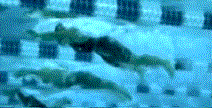HOW CHAMPIONS DO IT
Researched, produced, and prepared by Brent S. Rushall,
Ph.D., R.Psy.

JESSICA HARDY AT 40 m OF HER WINNING 50 m BREASTSTROKE A FINAL RACE AT THE 2010 PAN PAC SWIMMING CHAMPIONSHIPS
Jessica Hardy's time for this 50 m race was 30.03 seconds.
This stroke analysis includes a moving sequence in real time, a moving sequence where each frame is displayed for .5 of a second, and still frames.
The following image sequence is in real time. It will play through 10 times and then stop. To repeat the sequence, click the browser's "refresh" or "reload" button.

The following image sequence shows each frame for half a second. It will play through 10 times and then stop. To repeat the sequence, click the browser's "refresh" or "reload" button.

At the end of the following narrative, each frame is illustrated in detail in a sequential collage.
Notable Features
- Frame #1: The backward leg-extension of the kick is almost completed. As well as kicking back, the feet are also coming inward and downward. The vertical component of this kick keeps the swimmer's hips high on the surface. The arms and hands begin to part.
- Frame #2: The legs extend fully. The arms and hands continue to move to the side. There is no "outward-sculling" action.
- Frame #3: The legs are together. There is no attempt to streamline the feet by pointing the toes backward. The arms and hands are close to as wide as they will be positioned.
- Frame #4: The legs and hips remain streamlined. Hyperextension of the lower back allows the head and shoulders to begin to rise without altering the streamline of the trailing parts of the swimmer. The arms bend at the elbows and propulsive forces are set up to contain a horizontal and vertical force component.
- Frame #5: The head and upper surfaces of the shoulders have broken the water surface. Strong abduction of the upper arms produces considerable drag turbulence off the arms. The angle of the arms produces propulsion forward as well as vertical forces to support the raised head and shoulders. The lower portion of the swimmer trails in a streamlined fashion.
- Frame #6: The powerful but short arm action is almost complete. It remains well in front of the line of the face. Hyperextension of the lower back has allowed much movement in the front portion of the swimmer to support the breathing action, but the trailing portion remains very streamlined.
- Frame #7: The propulsive phase of the arm action is completed. The angle of the propulsive surface that provided the force component to lift the head and shoulders can be seen clearly. The hips and thighs begin to drop as the first step in initiating the kick. Breathing continues.
- Frame #8: The hands are brought inward and upward and slightly forward. The stroke is so short that the hands never come to be level with the face. The whole arm action occurs forward of the face. The hips and thighs continue to drop as the knees flex.
- Frame #9: The hands are at the surface and together. The knees continue to flex and the ankles dorsiflex.
- Frame #10: The hips begin to flex as the knees approach maximum flexion. The arms have started to be thrust forward. The head and shoulders start to be lowered (an inference drawn from the change in angle of the torso).
- Frame #11: The arms are thrust well forward. The legs are fully flexed and the feet are everted (turned-outward). The hips continue to flex. The angle of the torso continues to flatten.
- Frame #12: The arms are fully extended. The head has been lowered to be between the arms. The angle of the torso continues to flatten. The angle of flexion at the hips is maximal. That position causes the thighs to generate considerable frontal resistance causing one to wonder if the extra resistance is fully offset by the early kicking action (i.e., would a shorter kick be more beneficial?). The head has been lowered into the water.
- Frame #13: The position of Frame #1 is approached. The big powerful kick has provided propulsion and also facilitated streamlining of the body by keeping the hips high.
- Frames #14 and #15: The stroke cycle is repeated.
Jessica Hardy might well be described as a "kicker" because her short but useful arm action is in contrast to the full kicking action which involves both vertical and horizontal force components. If a swimmer has a very good fast kick, then this arms-kick balance might be appropriate. For swimmers with a less effective kick, more arms might have to be employed to produce a best form of swimming this stroke.
A modification of the arm action should be considered. Once propulsion is completed, the arms led by the hands should thrust forward directly to the depth where the arm-spread will begin. The swimmer's sequence of ceasing propulsion, bringing the hands inward and upward before extending along the surface produces unnecessary turbulence/resistance as well as taking longer, which also increases resistance. The direct recovery alternative would seem to be worthy of evaluation.

Return to Table of Contents for this section.

![]()



![]()